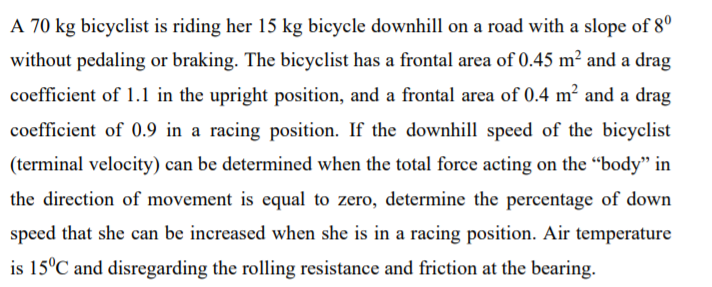A 70 kg bicyclist is riding her 15 kg bicycle downhill on a road with a slope of 8° without pedaling or braking. The bicyclist has a frontal area of 0.45 m² and a drag coefficient of 1.1 in the upright position, and a frontal area of 0.4 m² and a drag coefficient of 0.9 in a racing position. If the downhill speed of the bicyclist (terminal velocity) can be determined when the total force acting on the "body" in the direction of movement is equal to zero, determine the percentage of down speed that she can be increased when she is in a racing position. Air temperature is 15°C and disregarding the rolling resistance and friction at the bearing.
A 70 kg bicyclist is riding her 15 kg bicycle downhill on a road with a slope of 8° without pedaling or braking. The bicyclist has a frontal area of 0.45 m² and a drag coefficient of 1.1 in the upright position, and a frontal area of 0.4 m² and a drag coefficient of 0.9 in a racing position. If the downhill speed of the bicyclist (terminal velocity) can be determined when the total force acting on the "body" in the direction of movement is equal to zero, determine the percentage of down speed that she can be increased when she is in a racing position. Air temperature is 15°C and disregarding the rolling resistance and friction at the bearing.
Elements Of Electromagnetics
7th Edition
ISBN:9780190698614
Author:Sadiku, Matthew N. O.
Publisher:Sadiku, Matthew N. O.
ChapterMA: Math Assessment
Section: Chapter Questions
Problem 1.1MA
Related questions
Question
subject (fluid
pls show me full steps with clear handwriting sir
pls answer within 30 min sir

Transcribed Image Text:A 70 kg bicyclist is riding her 15 kg bicycle downhill on a road with a slope of 8°
without pedaling or braking. The bicyclist has a frontal area of 0.45 m? and a drag
coefficient of 1.1 in the upright position, and a frontal area of 0.4 m² and a drag
coefficient of 0.9 in a racing position. If the downhill speed of the bicyclist
(terminal velocity) can be determined when the total force acting on the “body" in
the direction of movement is equal to zero, determine the percentage of down
speed that she can be increased when she is in a racing position. Air temperature
is 15°C and disregarding the rolling resistance and friction at the bearing.
Expert Solution
This question has been solved!
Explore an expertly crafted, step-by-step solution for a thorough understanding of key concepts.
Step by step
Solved in 2 steps with 2 images

Knowledge Booster
Learn more about
Need a deep-dive on the concept behind this application? Look no further. Learn more about this topic, mechanical-engineering and related others by exploring similar questions and additional content below.Recommended textbooks for you

Elements Of Electromagnetics
Mechanical Engineering
ISBN:
9780190698614
Author:
Sadiku, Matthew N. O.
Publisher:
Oxford University Press

Mechanics of Materials (10th Edition)
Mechanical Engineering
ISBN:
9780134319650
Author:
Russell C. Hibbeler
Publisher:
PEARSON

Thermodynamics: An Engineering Approach
Mechanical Engineering
ISBN:
9781259822674
Author:
Yunus A. Cengel Dr., Michael A. Boles
Publisher:
McGraw-Hill Education

Elements Of Electromagnetics
Mechanical Engineering
ISBN:
9780190698614
Author:
Sadiku, Matthew N. O.
Publisher:
Oxford University Press

Mechanics of Materials (10th Edition)
Mechanical Engineering
ISBN:
9780134319650
Author:
Russell C. Hibbeler
Publisher:
PEARSON

Thermodynamics: An Engineering Approach
Mechanical Engineering
ISBN:
9781259822674
Author:
Yunus A. Cengel Dr., Michael A. Boles
Publisher:
McGraw-Hill Education

Control Systems Engineering
Mechanical Engineering
ISBN:
9781118170519
Author:
Norman S. Nise
Publisher:
WILEY

Mechanics of Materials (MindTap Course List)
Mechanical Engineering
ISBN:
9781337093347
Author:
Barry J. Goodno, James M. Gere
Publisher:
Cengage Learning

Engineering Mechanics: Statics
Mechanical Engineering
ISBN:
9781118807330
Author:
James L. Meriam, L. G. Kraige, J. N. Bolton
Publisher:
WILEY